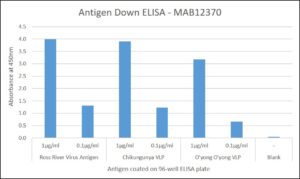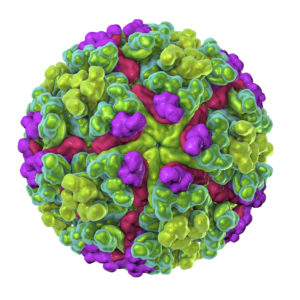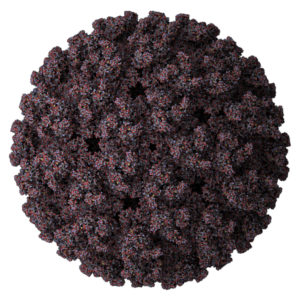
ELISA: Antigen down ELISA with 96-well plate coated with 100µl of 1µg/ml Ross River virus antigen (REC31969), O’nyong-nyong VLP (REC31626) and Chikungunya VLP (CHIKV-VLP). Primary antibody MAB12370 added at 0.5µg/ml and 100µl of Goat anti-mouse IgG HRP secondary antibody (1:10,000). Reaction stopped with 100µl of 1M HCl and detection carried out using TMB substrate at 405/450nm.
Mouse Anti-Ross River Virus E2 Glycoprotein (D7)
$548.65 excl. VAT
Mouse anti Ross River virus E2 monoclonal antibody (clone D7) recognises the Ross River virus (RRV) E2 Envelope glycoprotein and is suitable for ELISA (REC31969), flow cytometry and cell staining applications.
MOUSE ANTI-ROSS RIVER VIRUS E2 GLYCOPROTEIN (D7)
Mouse anti Ross River virus E2 antibody (clone D7) recognises the Ross River virus (RRV) E2 Envelope glycoprotein.
PRODUCT DETAILS – MOUSE ANTI-ROSS RIVER VIRUS E2 GLYCOPROTEIN (D7)
- Mouse Anti Ross River virus antibody (clone D7) monoclonal antibody.
- Suitable for staining RRV-positive cells and can be used in Flow cytometry (FC) analysis of E2 surface expression. It can also be used to detect RRV binding to cells. Detects a ~50kDa band on Western blot in reduced conditions.
- Purified by Protein G Sepharose chromatography.
- Presented in PBS with 0.02% Proclin 300.
BACKGROUND
Ross River fever (RRF), also known as epidemic polyarthritis, is an illness caused by infection with the Ross River virus, which is related to another mosquito-borne virus, Barmah Forest virus (BFV). The virus was first isolated in 1959 from a mosquito trapped along the Ross River in Townsville, Queensland. Since then, outbreaks have occurred in all Australian states, including Tasmania, and metropolitan areas. RRV and BFV are the two most common mosquito-borne viruses in Western Australia. RRV infection cannot be spread from human to human. It is spread from animals to humans by a number of different types of mosquitoes with Culex annulirostris, Aedes vigilax (salt marsh mosquito) and Aedes notoscriptus being most common. Aedes vigilax breeds in salty pools in mangroves and salt marshes after flooding by spring tides and heavy rains. Culex annulirostris breeds in permanent bodies of fresh water while Aedes notoscriptus breeds in containers close to homes and other human activity.
People suffering from RRV or BFV diseases may experience a wide range of symptoms common to both viruses. Symptoms and their severity vary from person to person but can include painful and/or swollen joints (the most commonly affected joints are the wrists, knees, ankles, fingers, elbows, shoulders and jaw). Pain usually develops quickly and may be intense and more severe in different joints at different times. Joint pain is much more common than swelling. Other symptoms include sore muscles, aching tendons, skin rashes (although these tend to be more common to BFV disease), fever, tiredness, headaches and swollen lymph nodes. Fever, nausea and skin rashes usually disappear within the first 2 weeks of illness. Joint, muscle and tendon pain may last much longer, upto 3 months. In rare cases, symptoms can persist or recur for up to a year or more. BFV symptoms may not last as long as those for RRV.
Ross River virus belongs to the virus genus Alphavirus (family Togaviridae), a group of small enveloped single-strand positive-sense RNA viruses. The genome of the T48 strain of RRV is 11,853 nucleotides in length and codes for four nonstructural proteins (nsP1 to nsP4), a capsid protein, and three envelope glycoproteins (E1, E2 and E3). The E3 glycoprotein is not incorporated into the virion. The capsid protein and the genome form the nucleocapsid, which is about 400 Å in diameter, contains 240 copies of the capsid protein, and has T = 4 icosahedral symmetry. T is the triangulation number, giving a multiplier of 60 that gives the number of subunits in the virus structure. The E1 and E2 viral glycoproteins are embedded in the lipid bilayer to form the envelope. Single E1 and E2 molecules associate to form heterodimers and these E1-E2 heterodimers form one-to-one contacts between E2 and nucleocapsid monomers (Harley et al., 2001).
REFERENCES
- Ross River virus. 2019 Northern Territory Government of Australia.
- Harley et al. (2001). Ross River virus transmission, infection, and disease: a cross-disciplinary review. Clin Microbiol Rev. 14(4):909-32.



